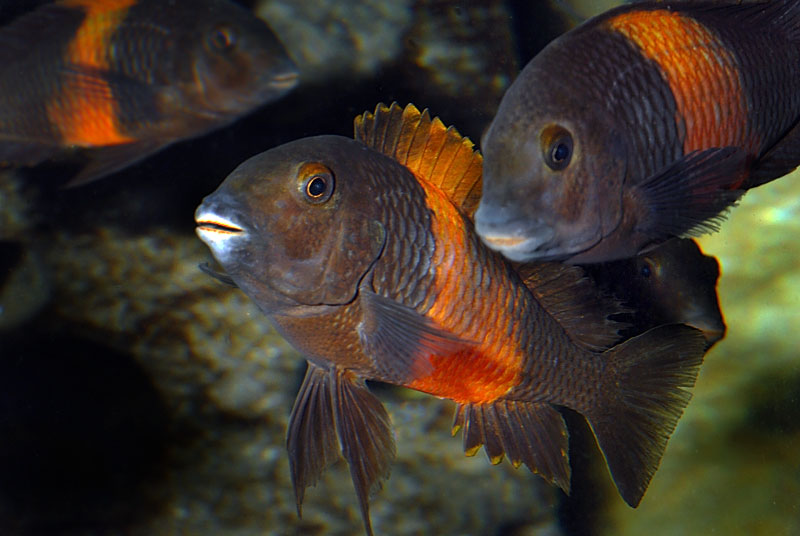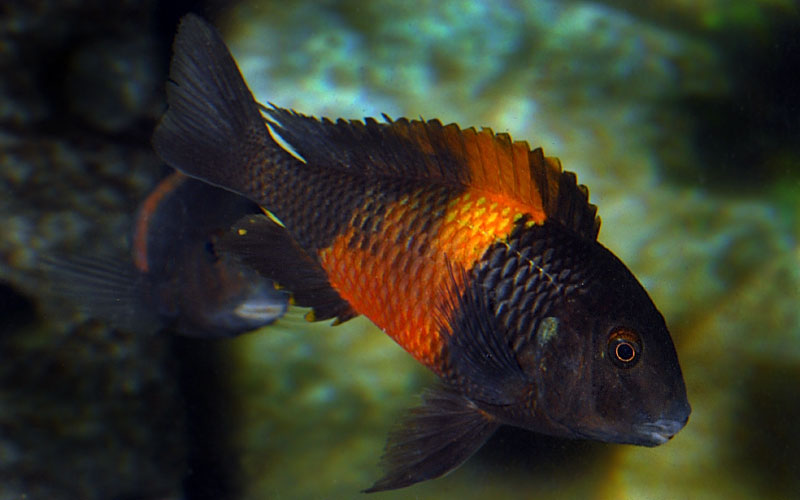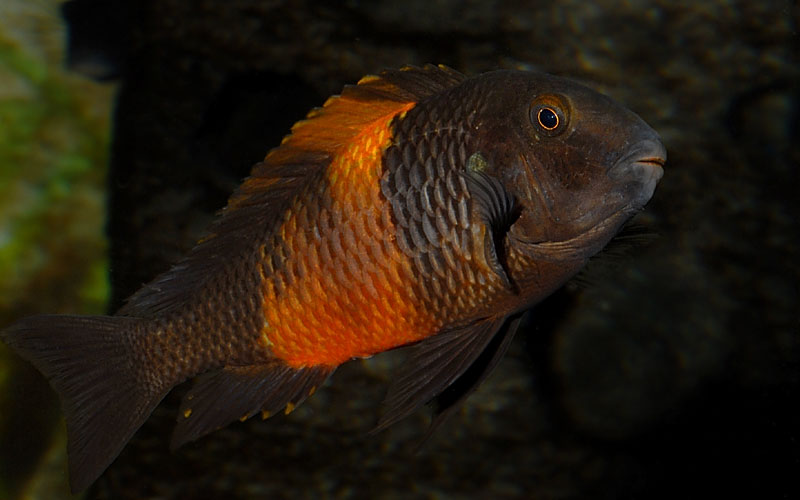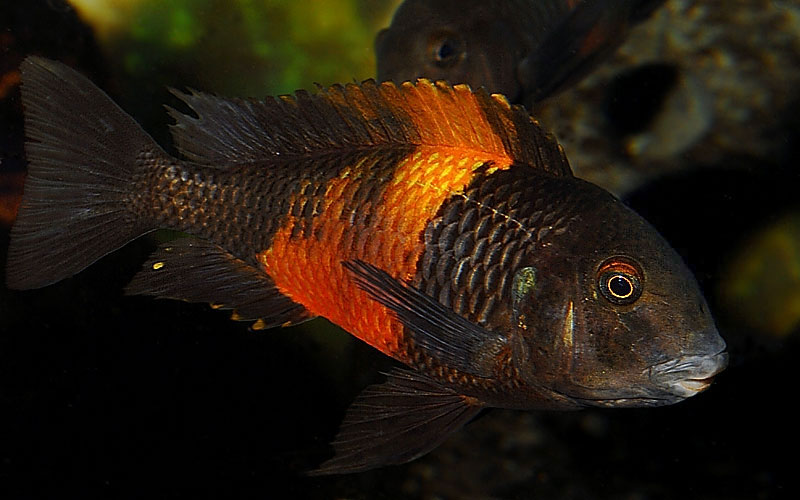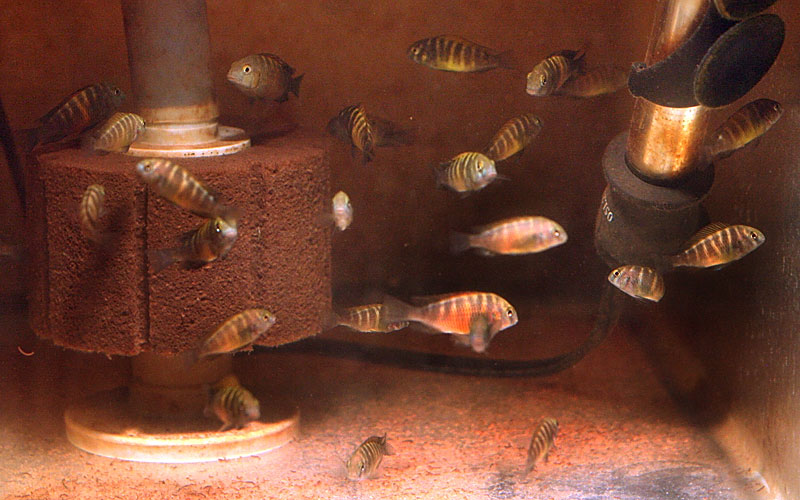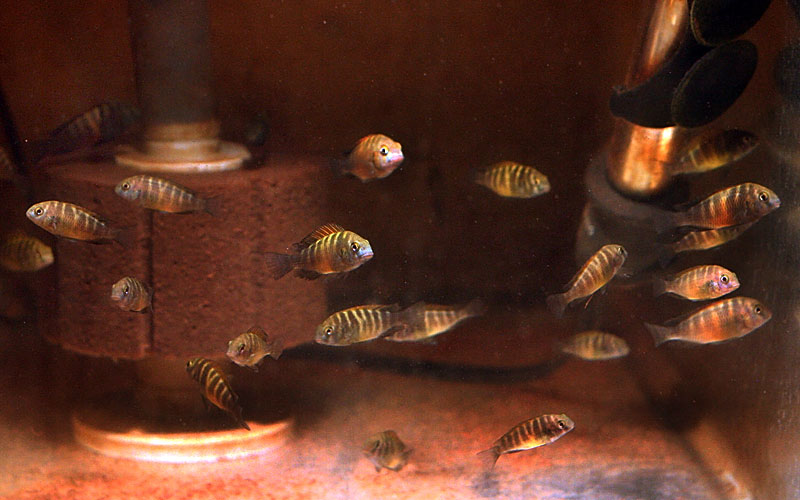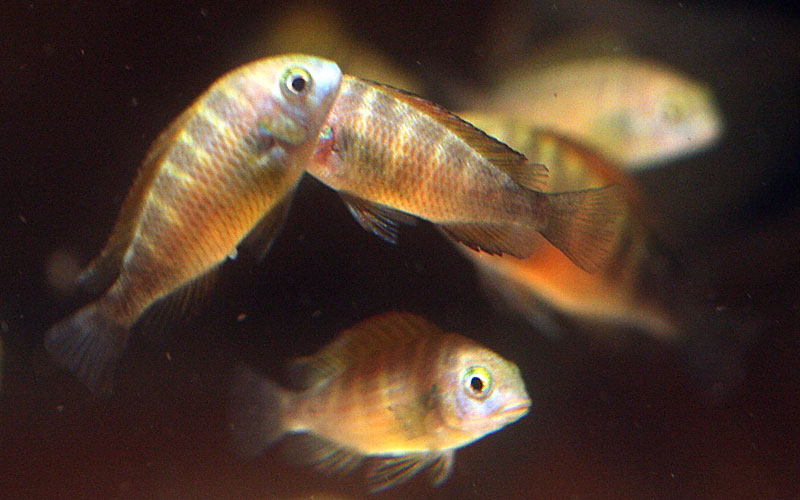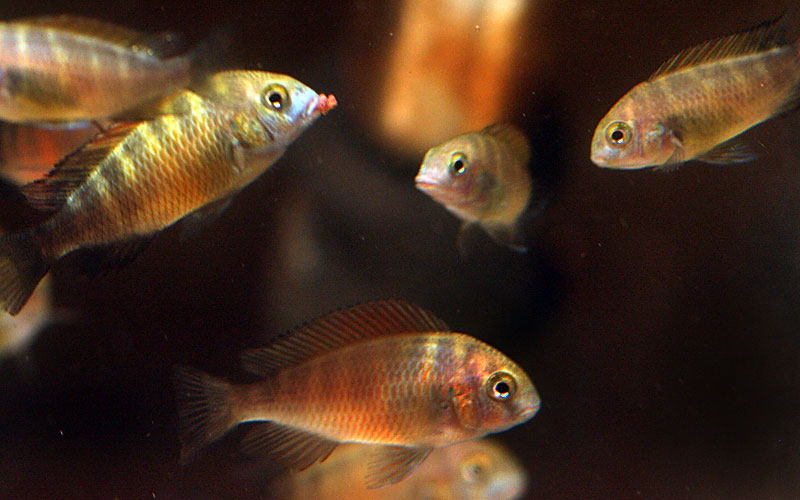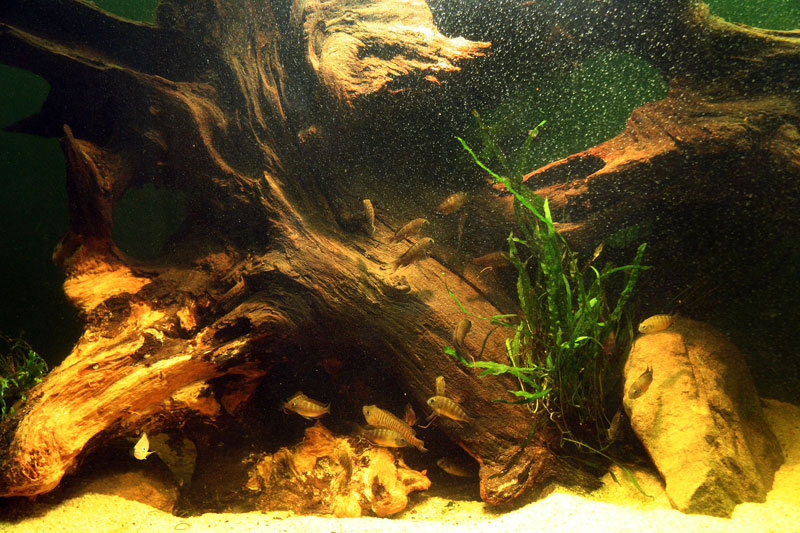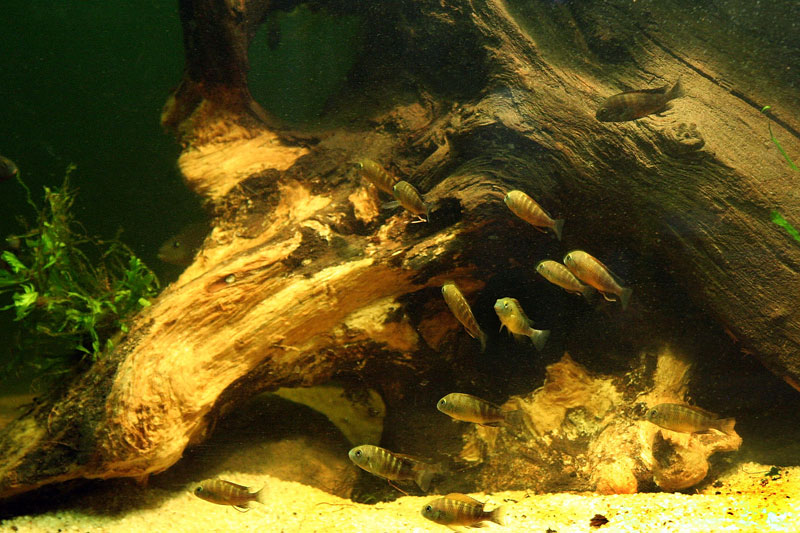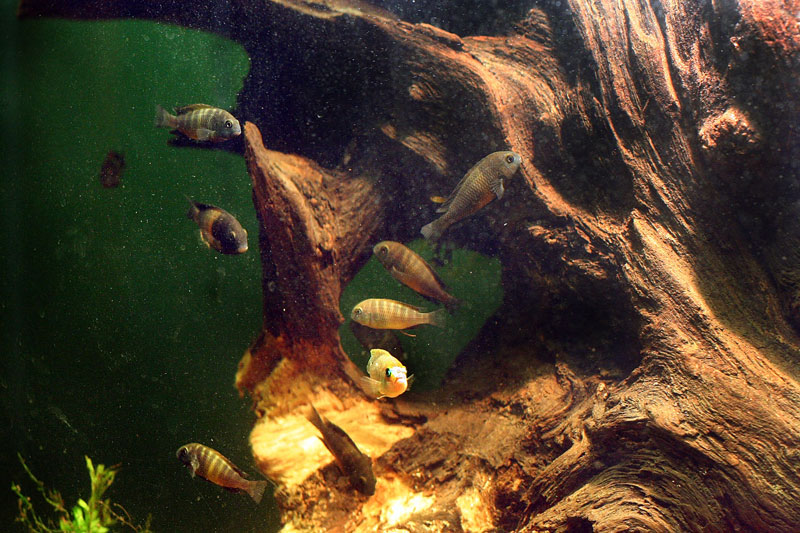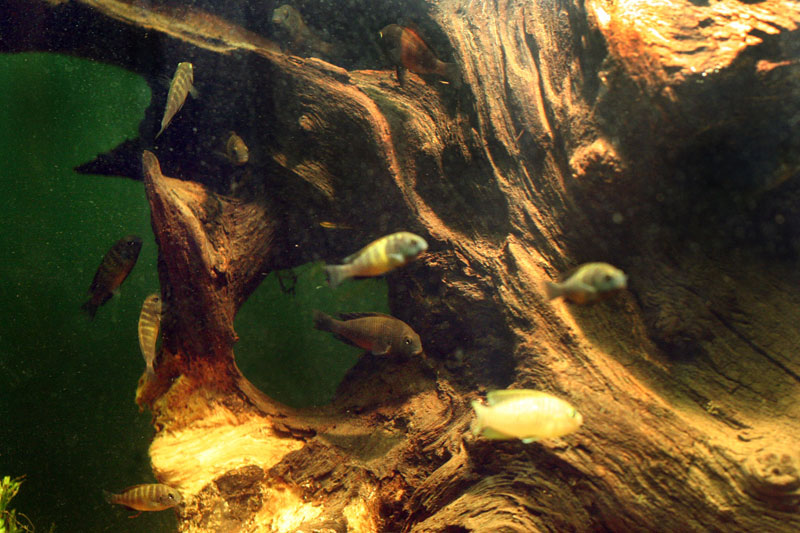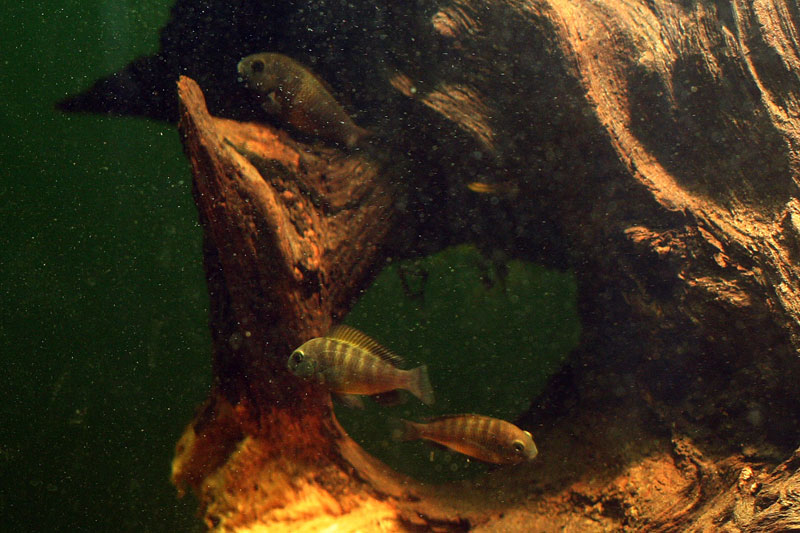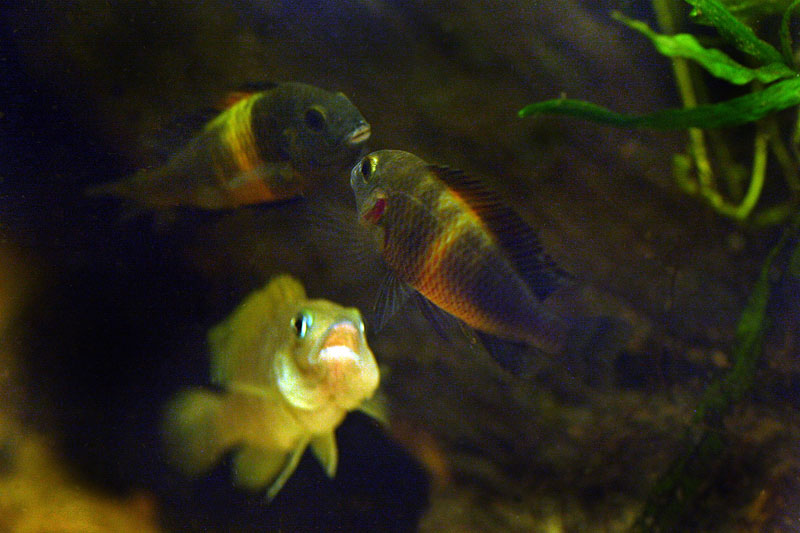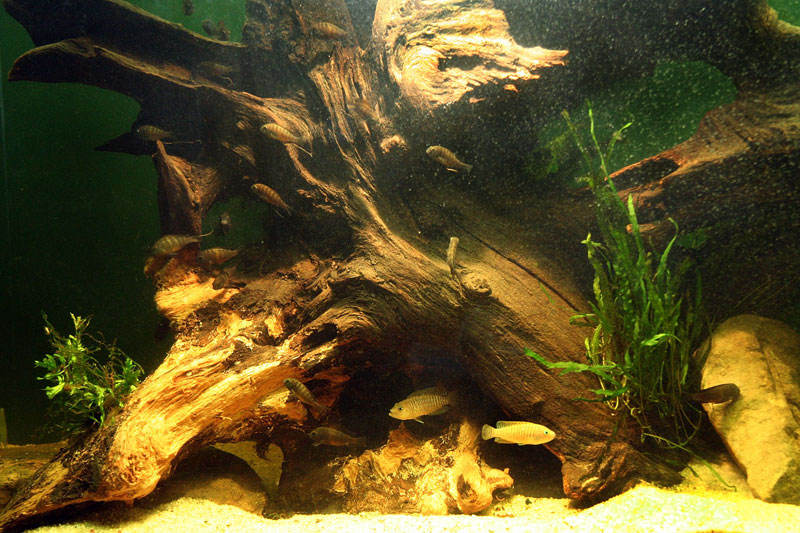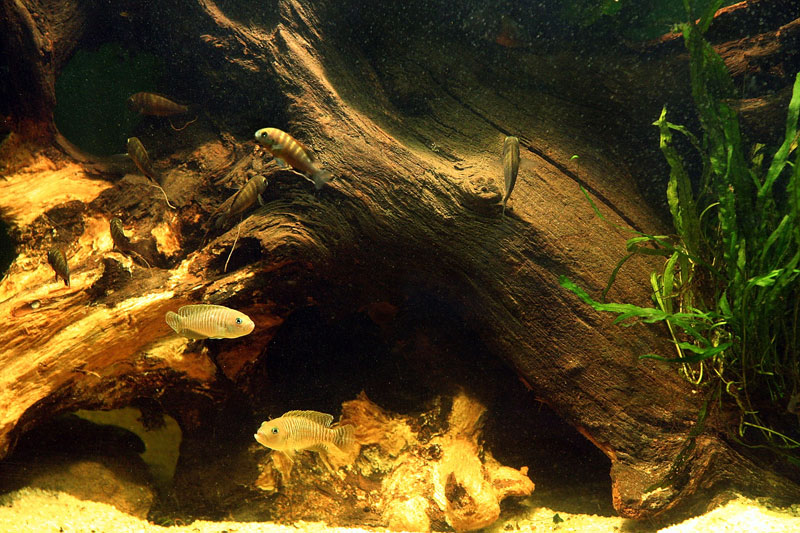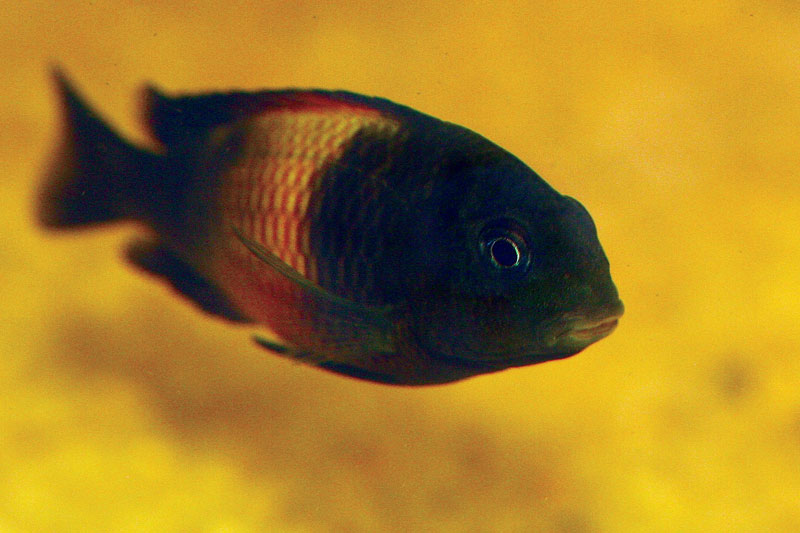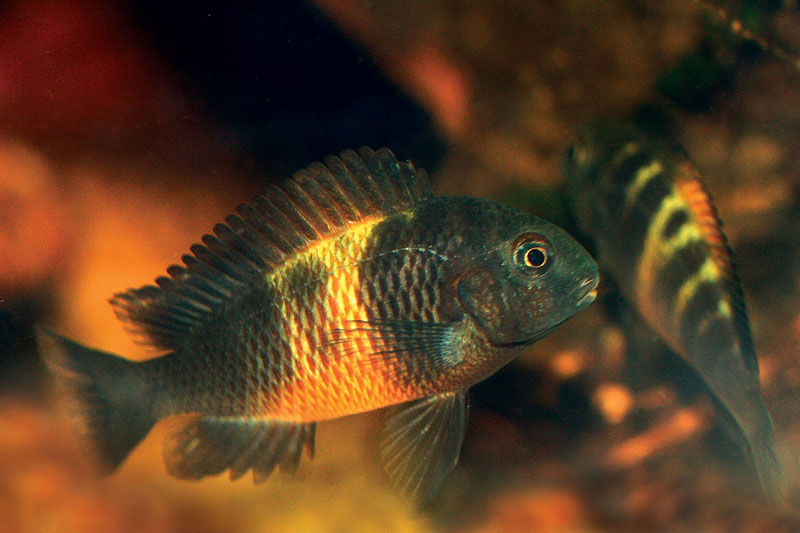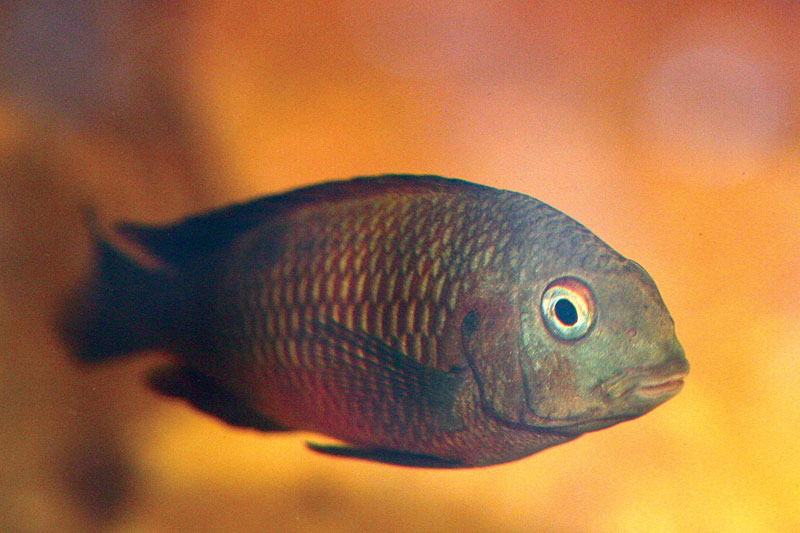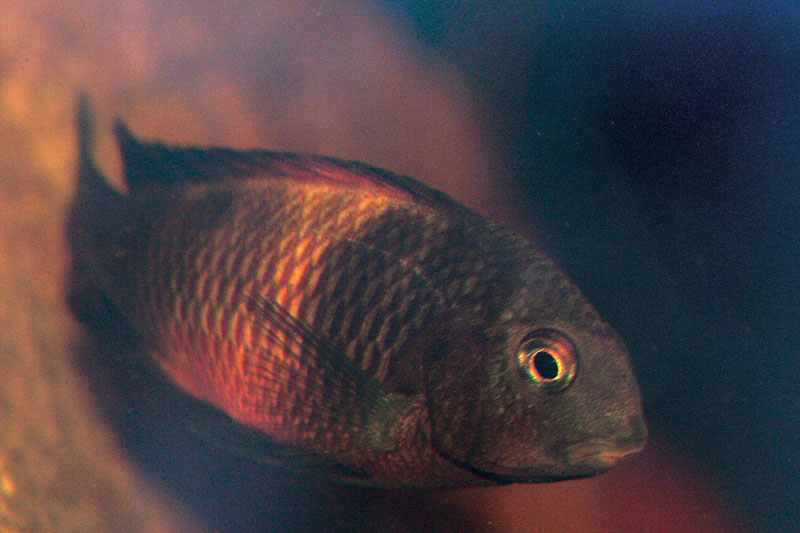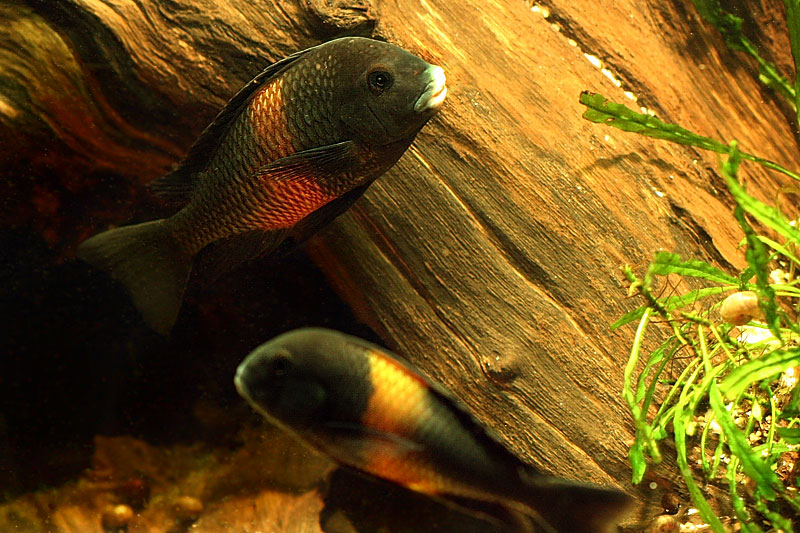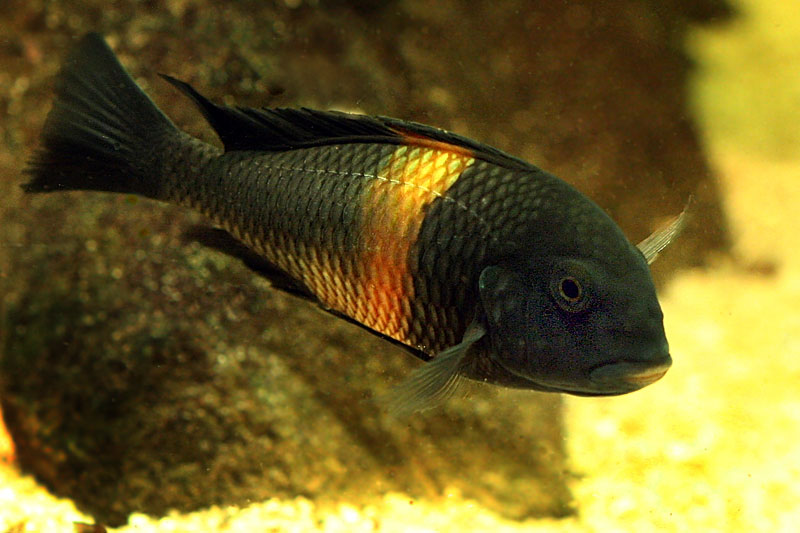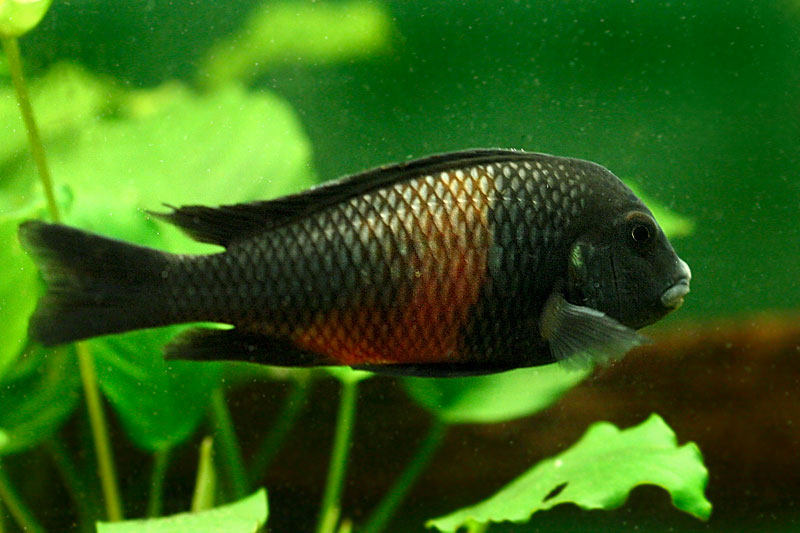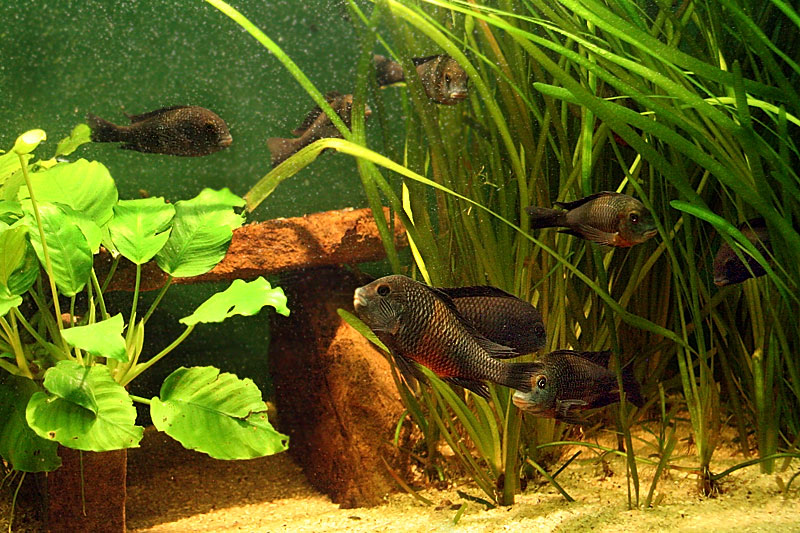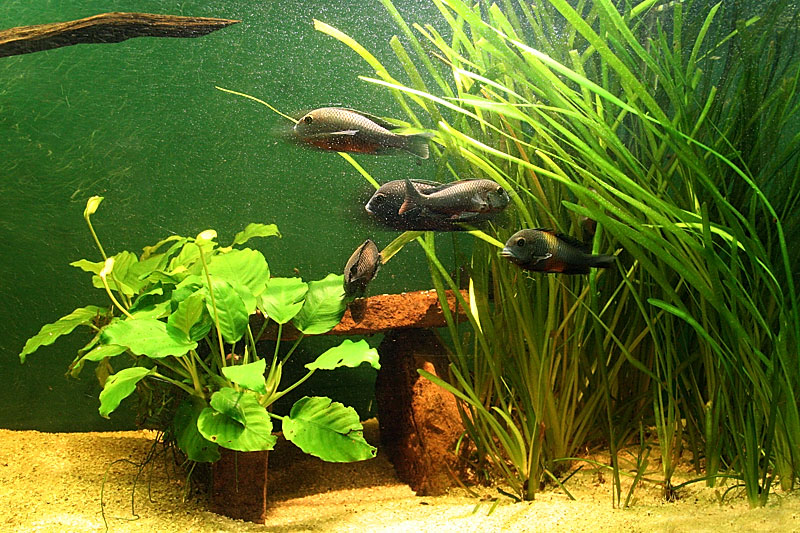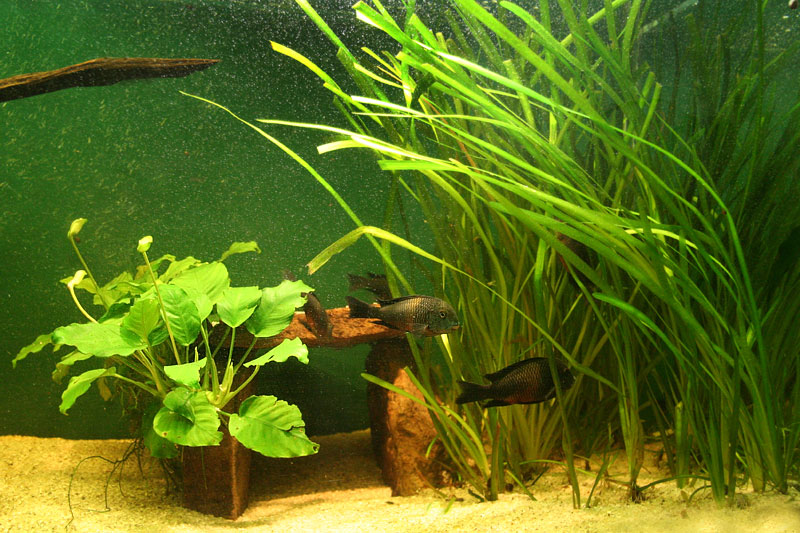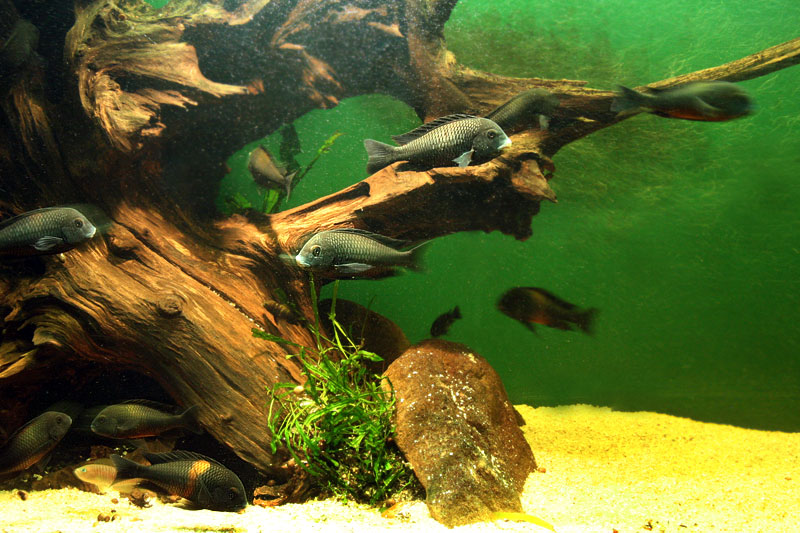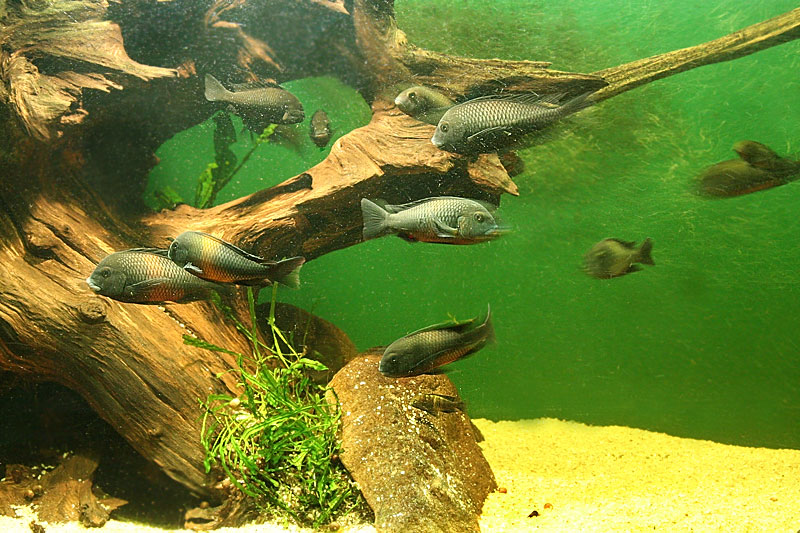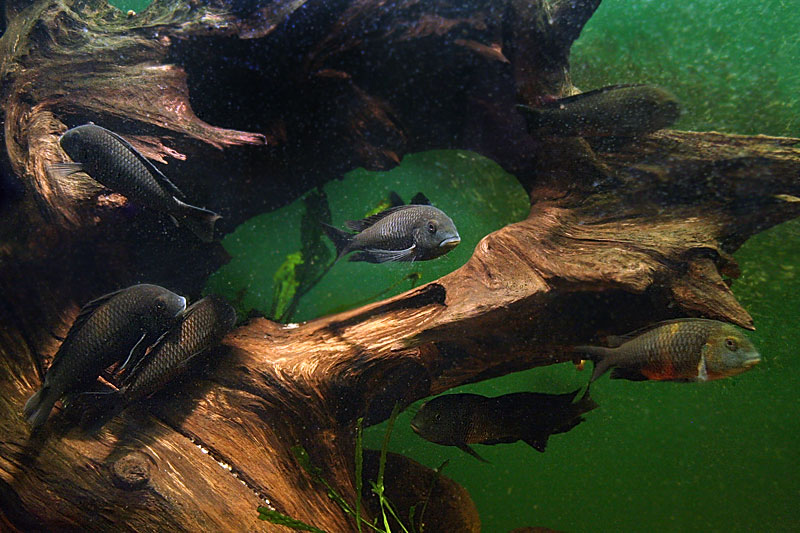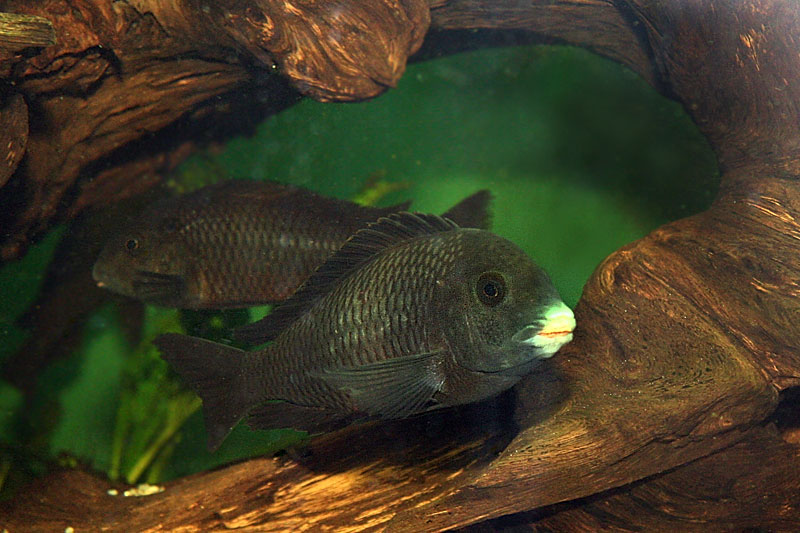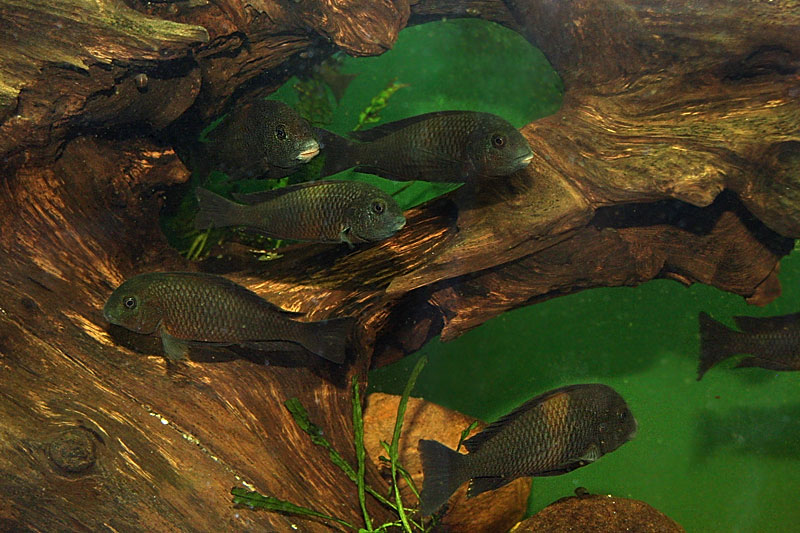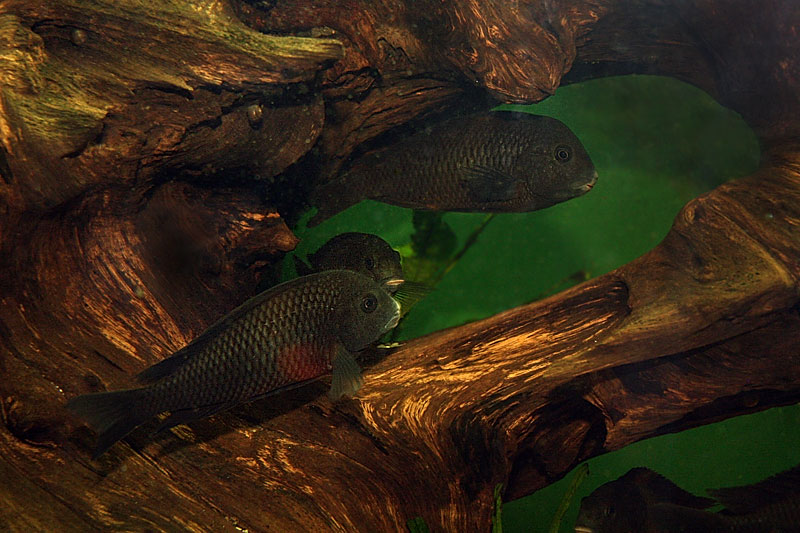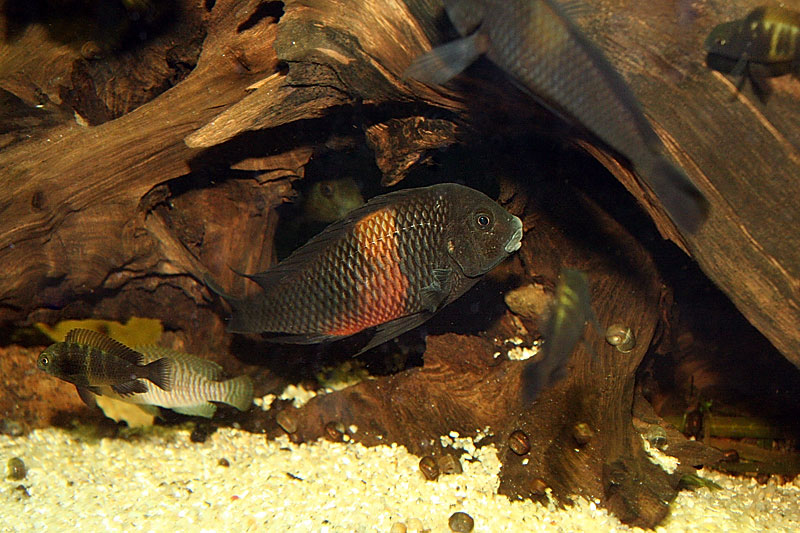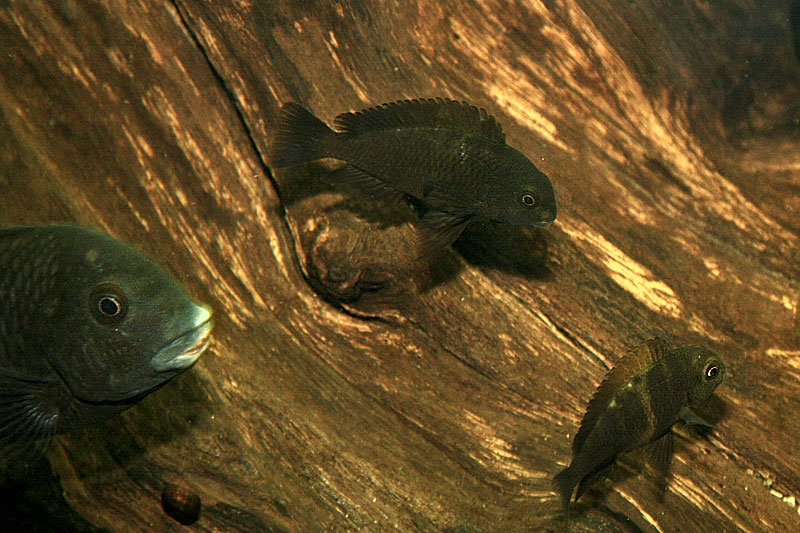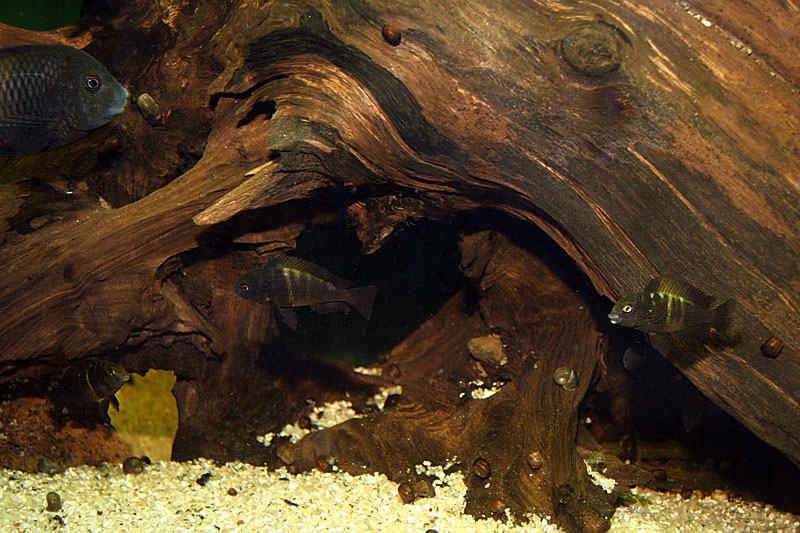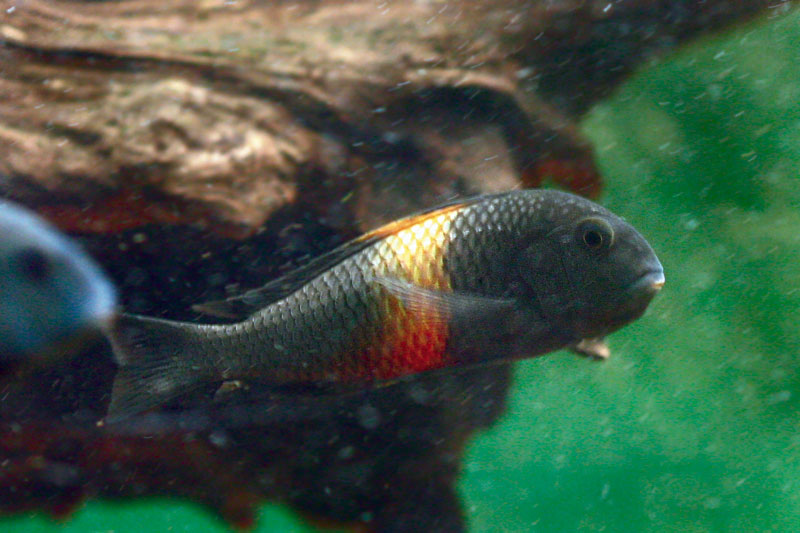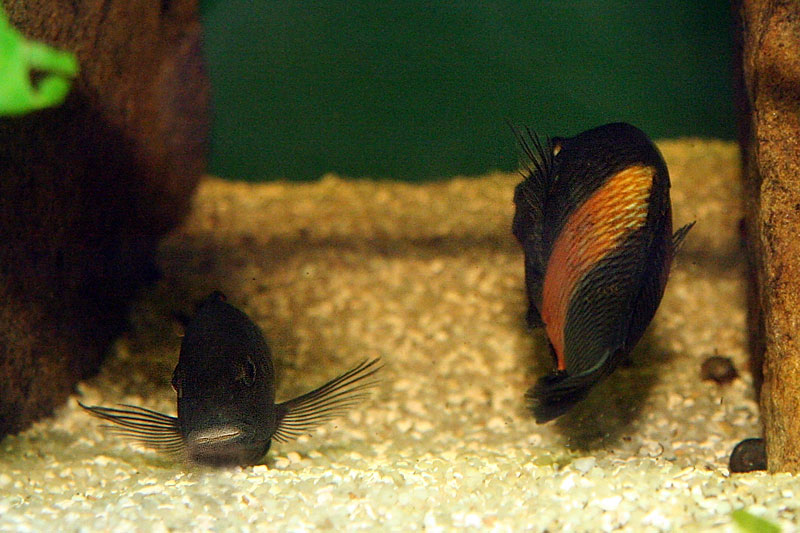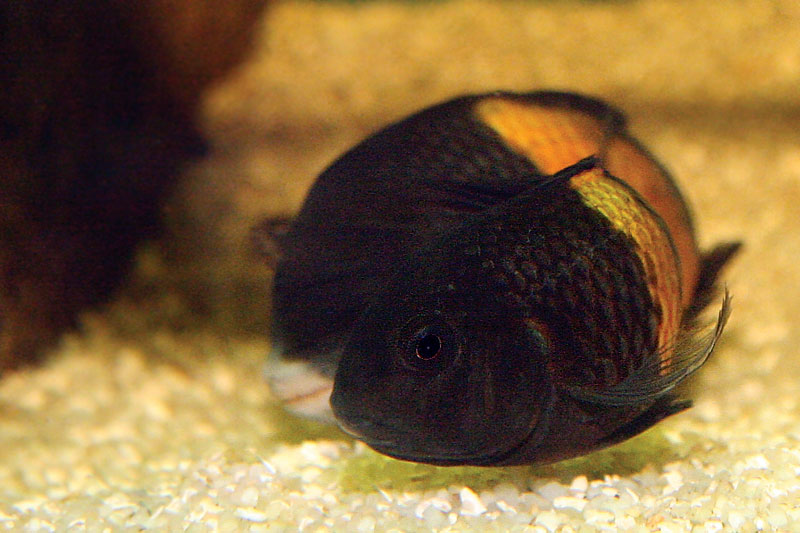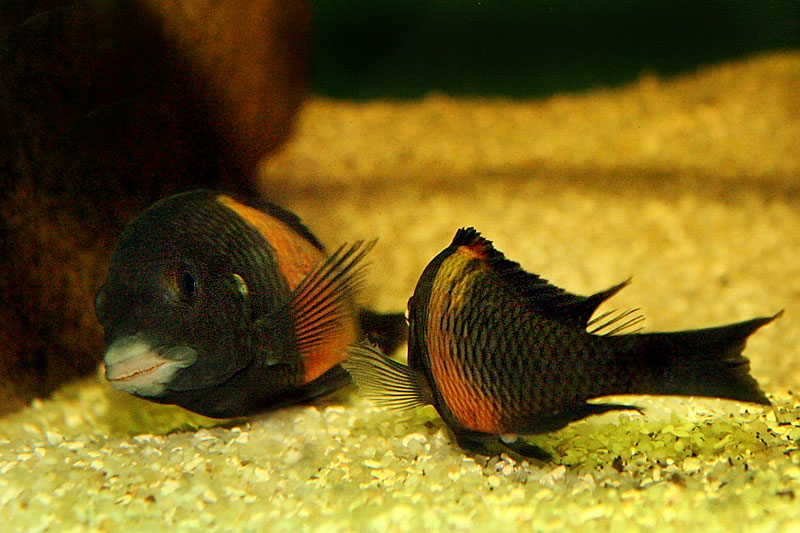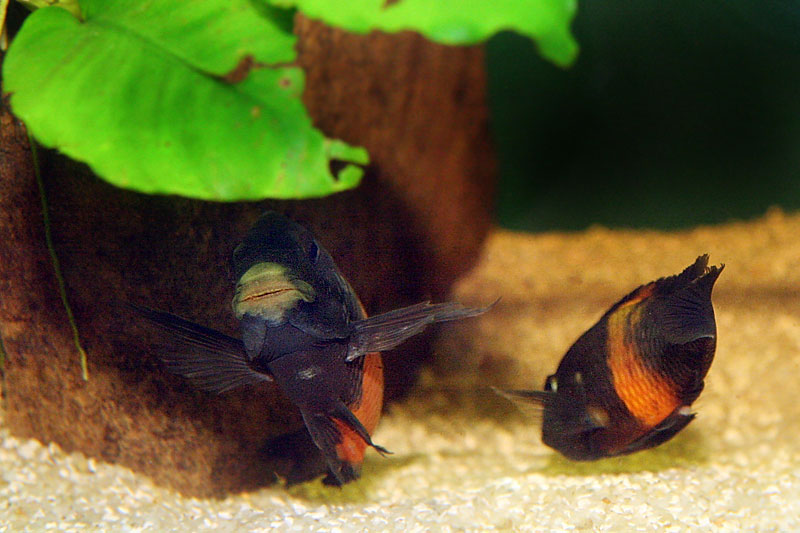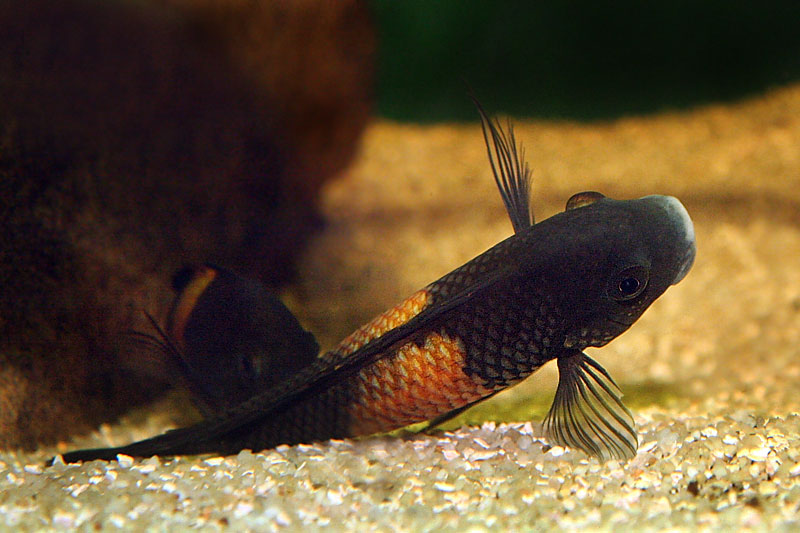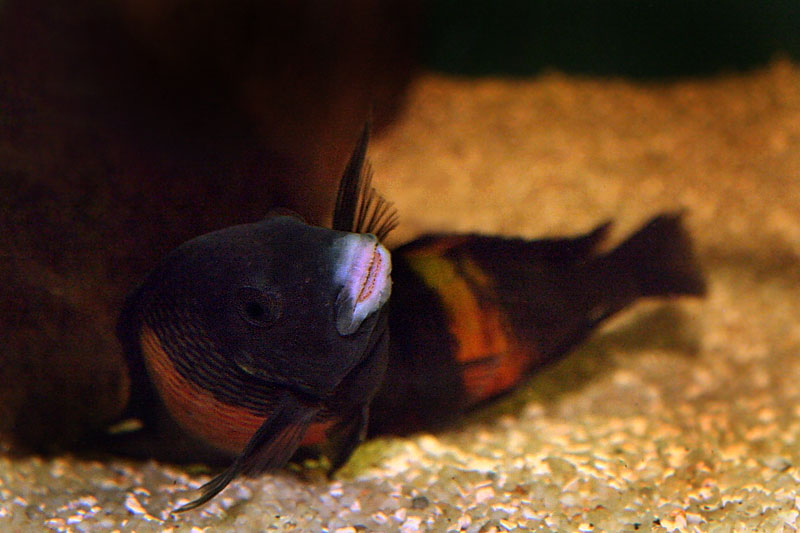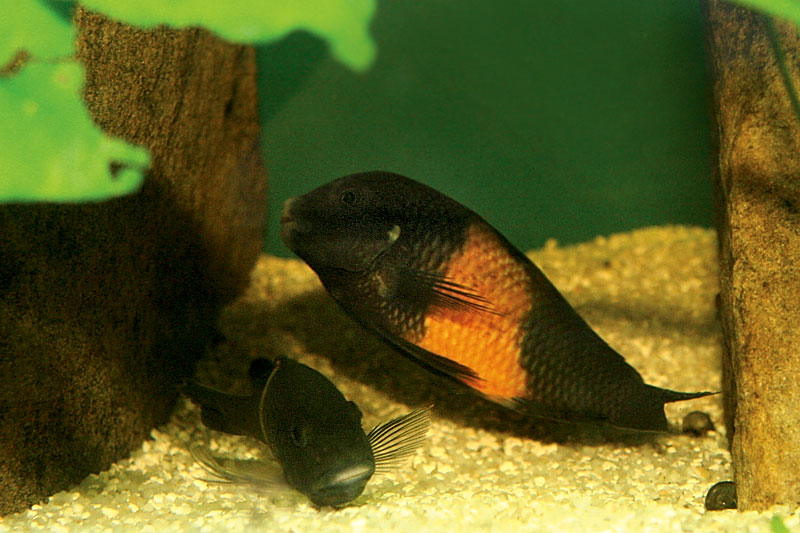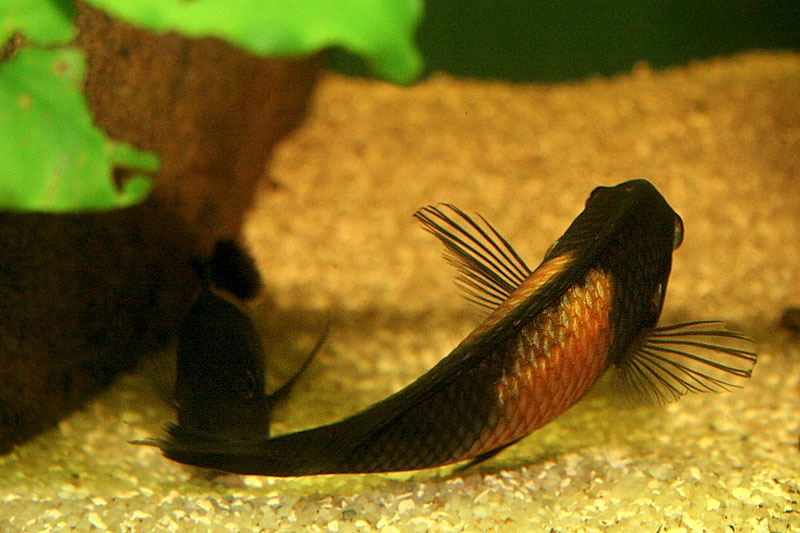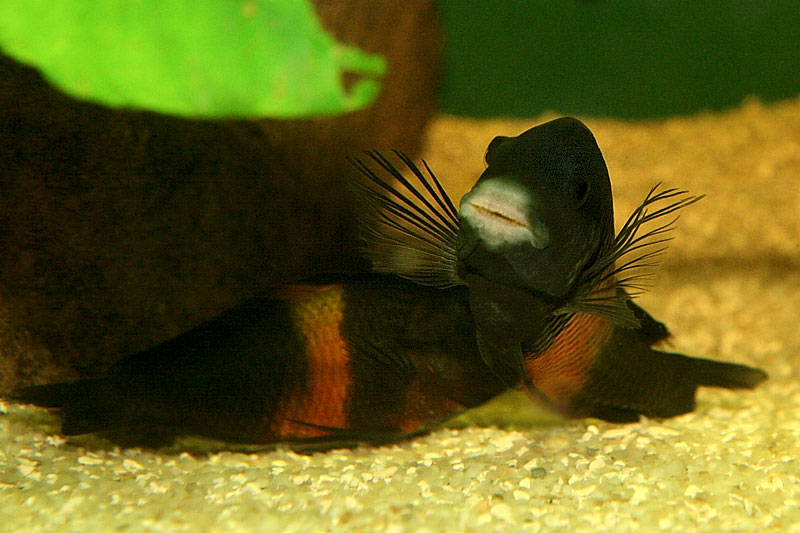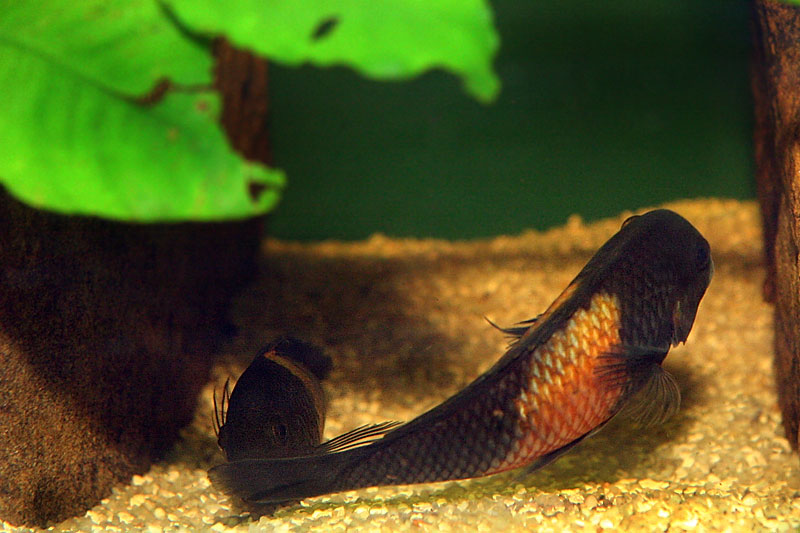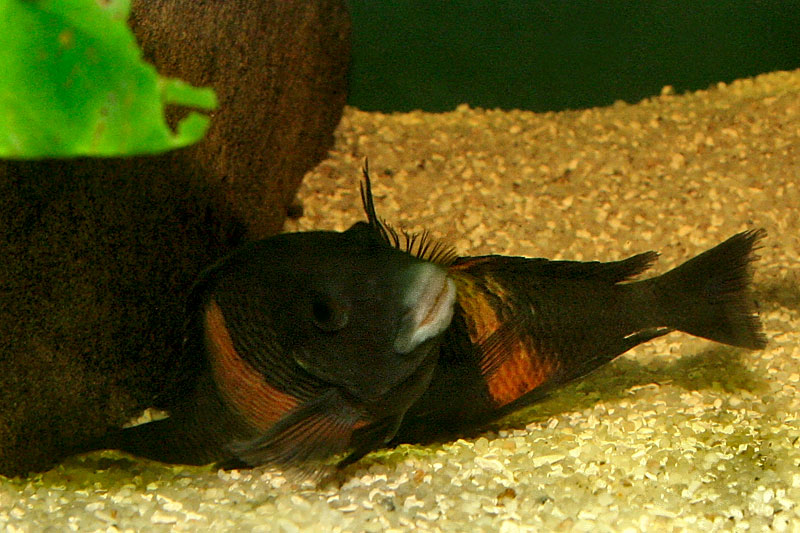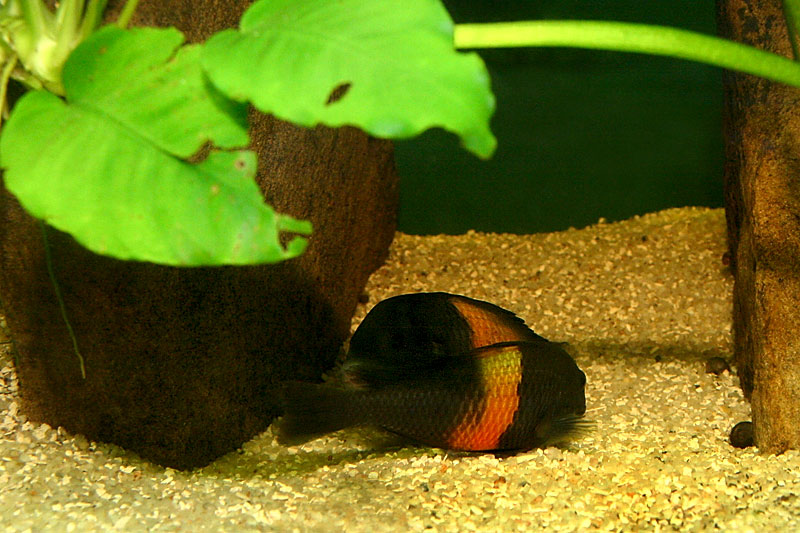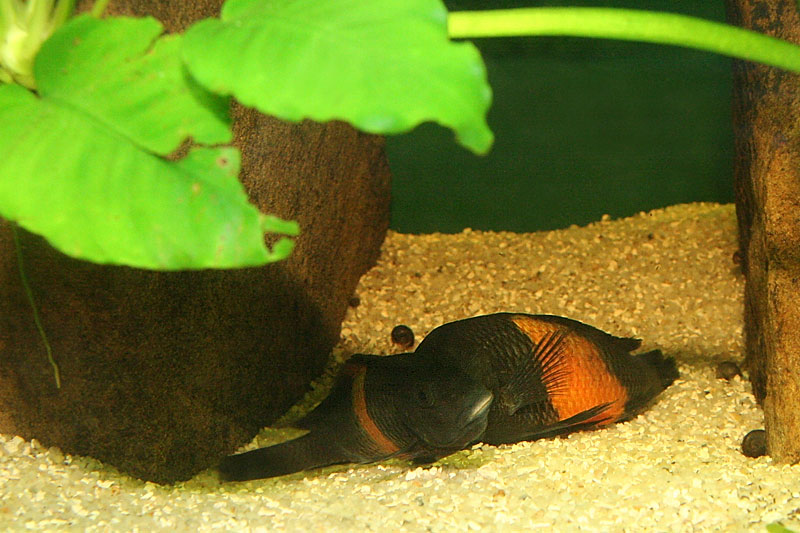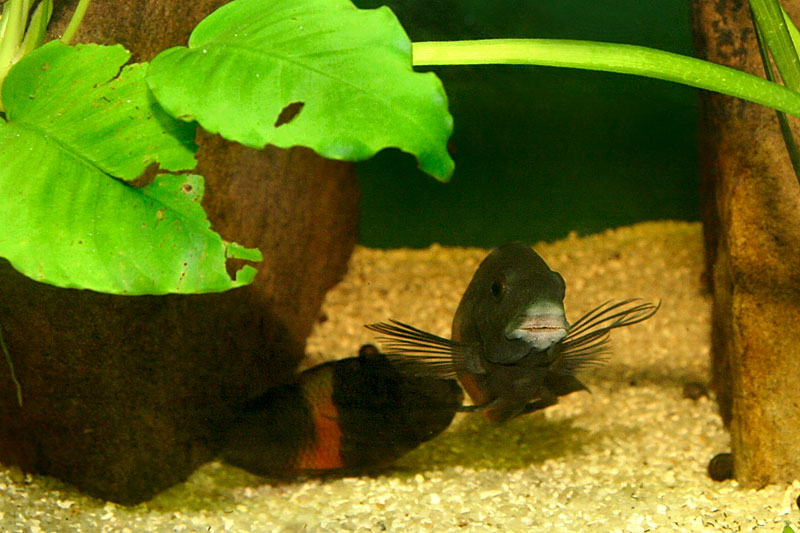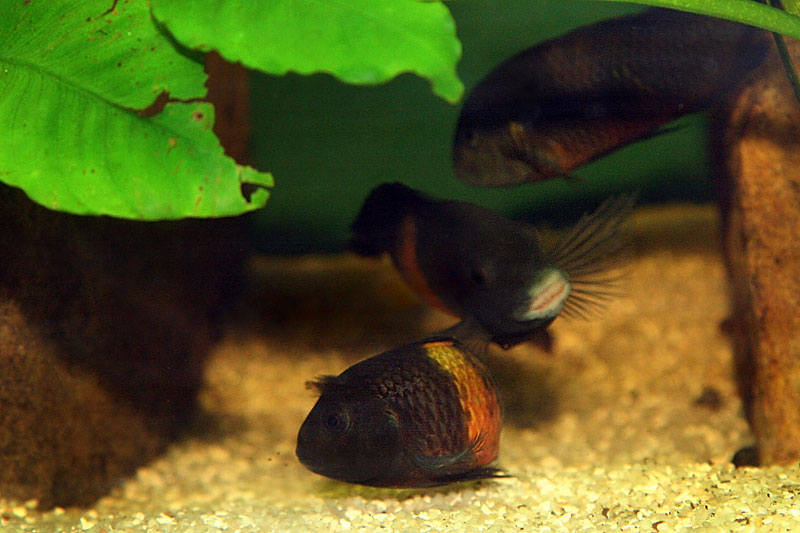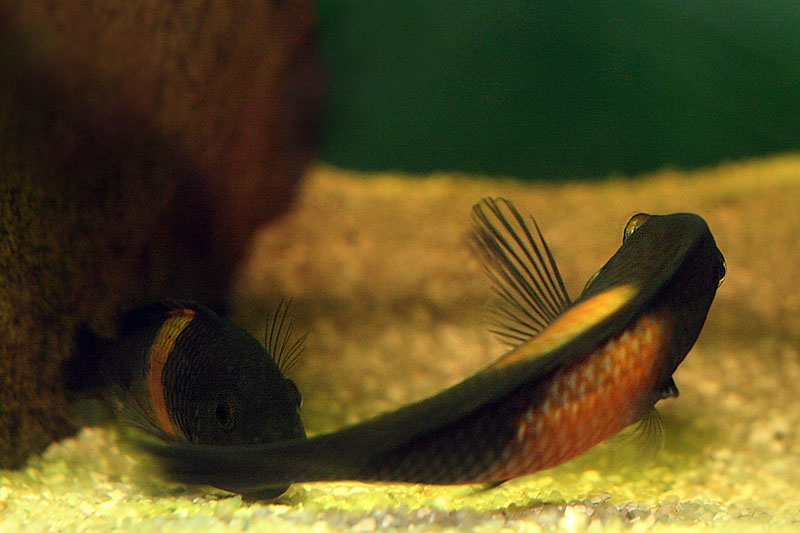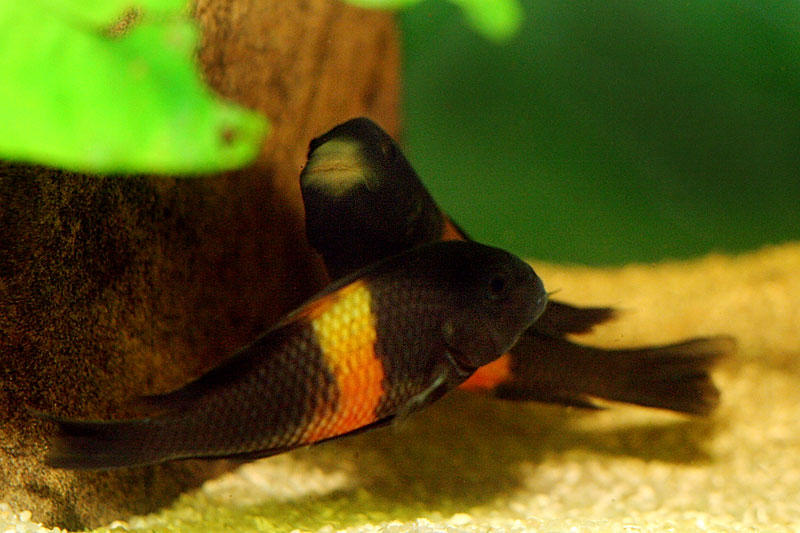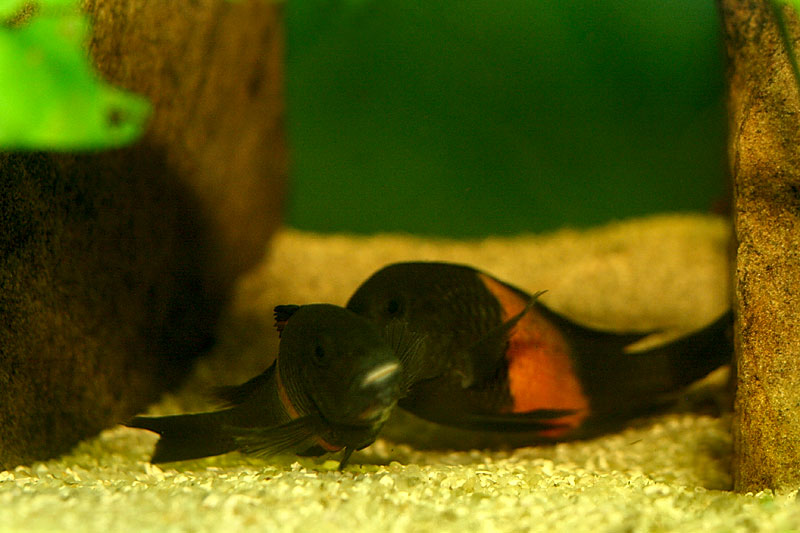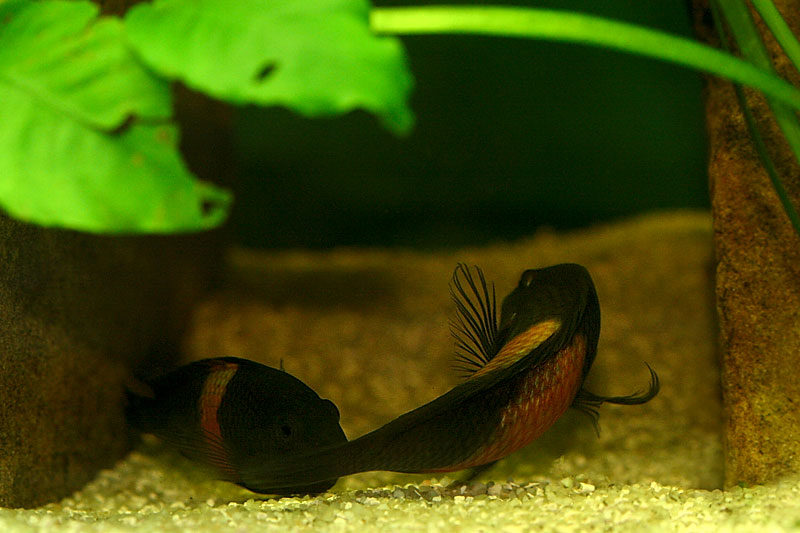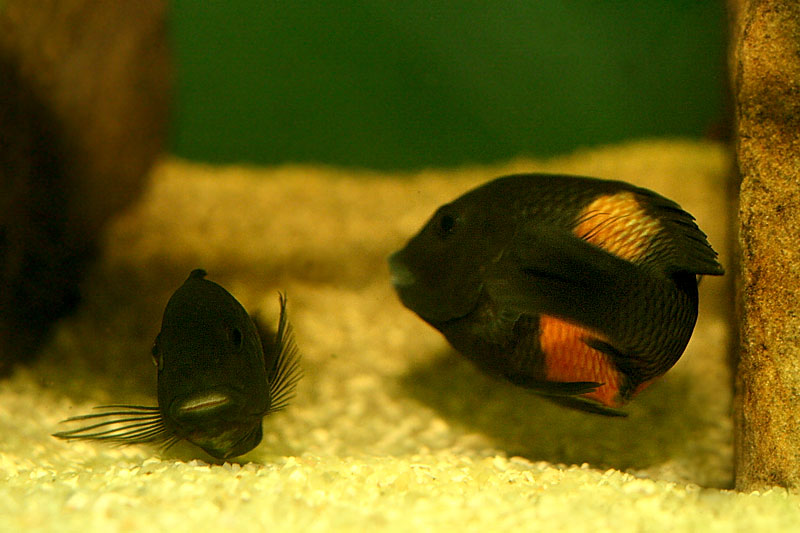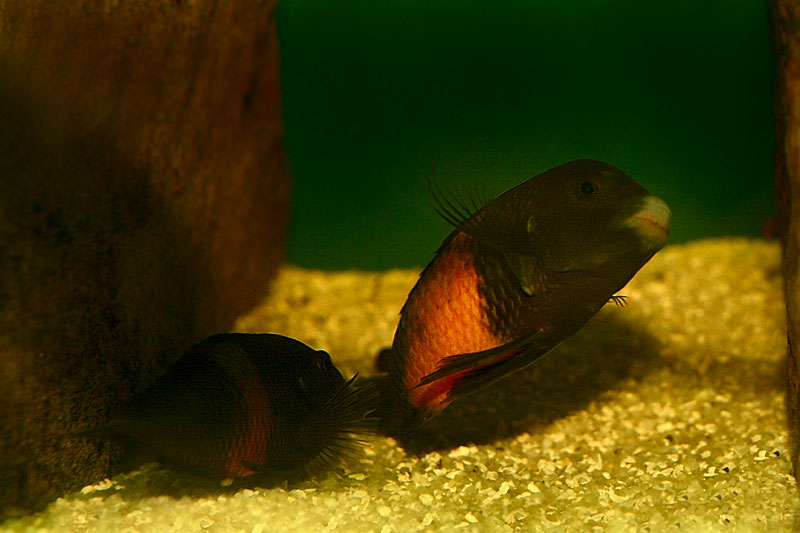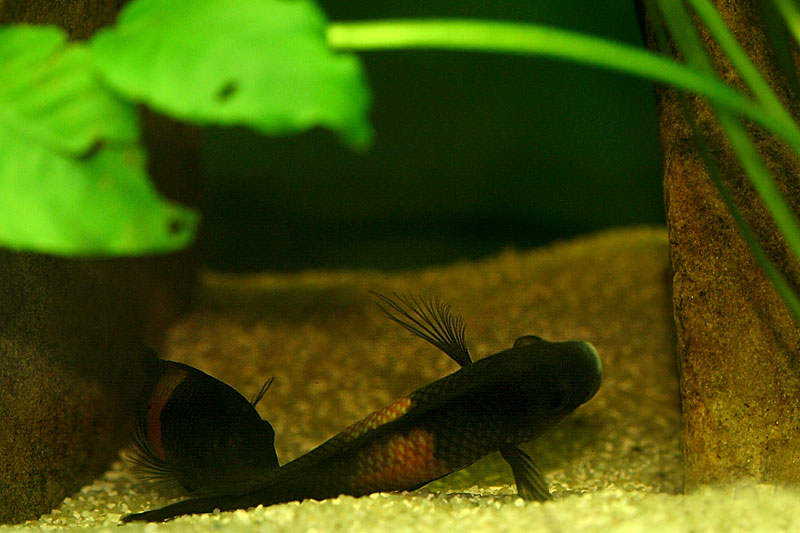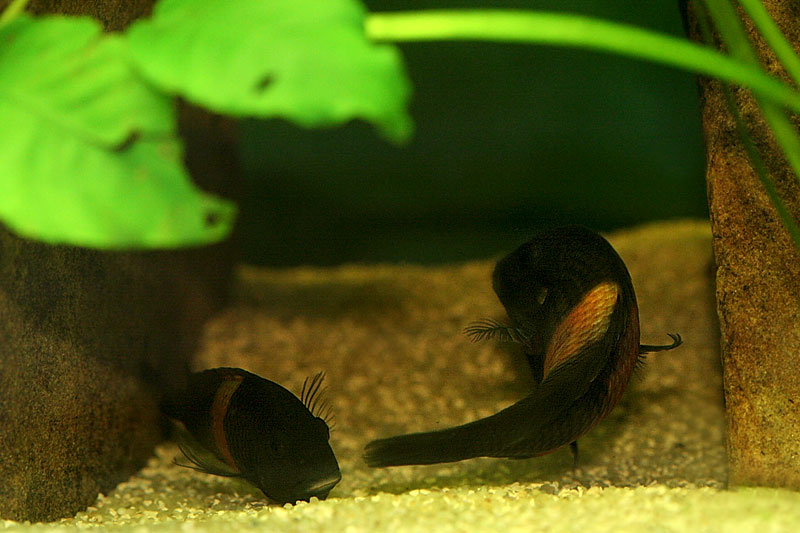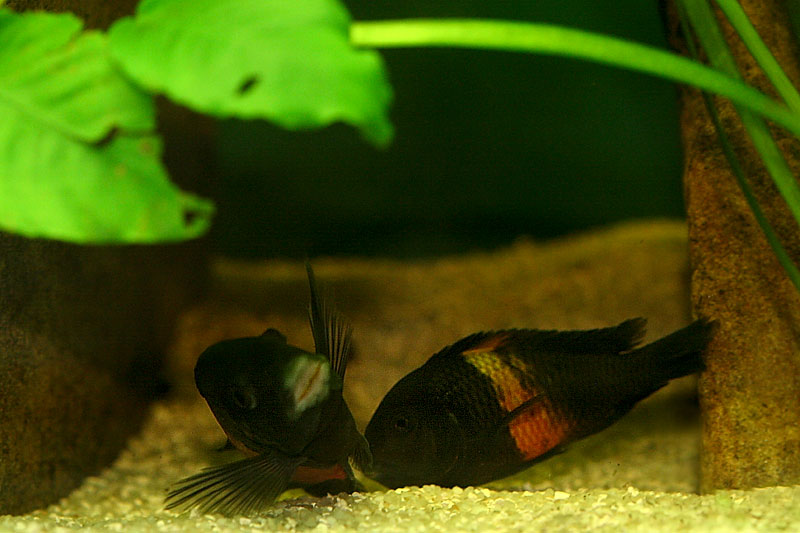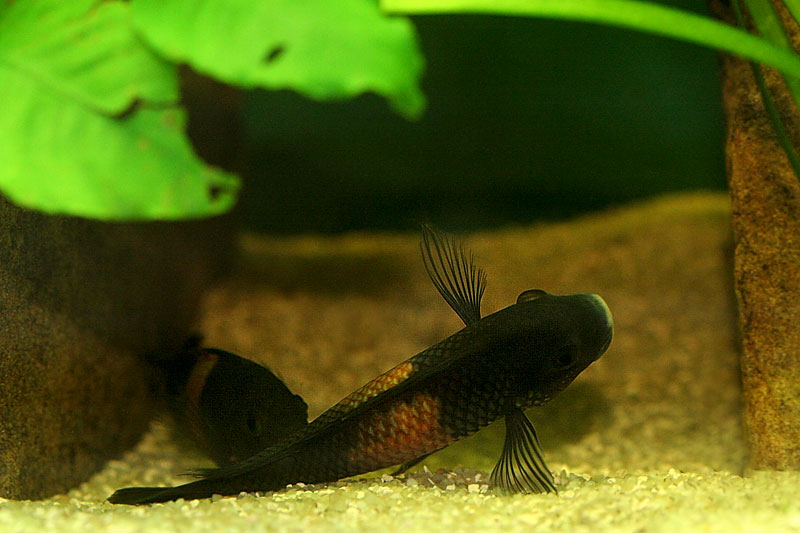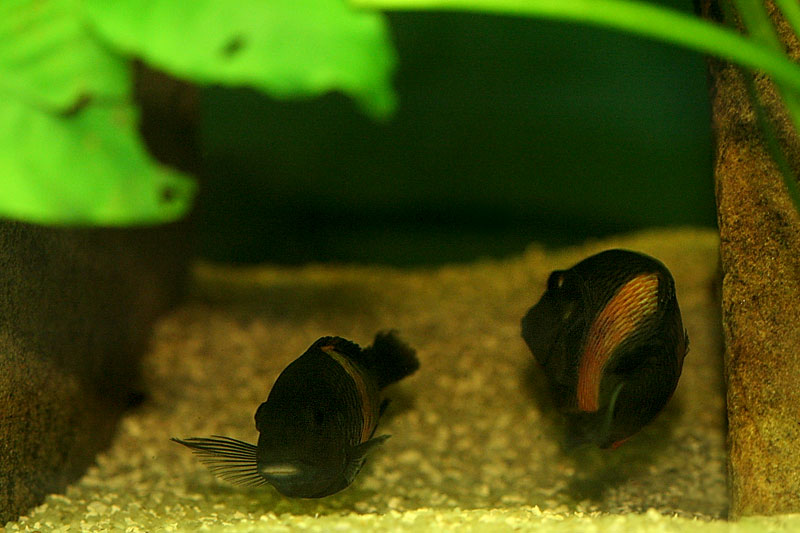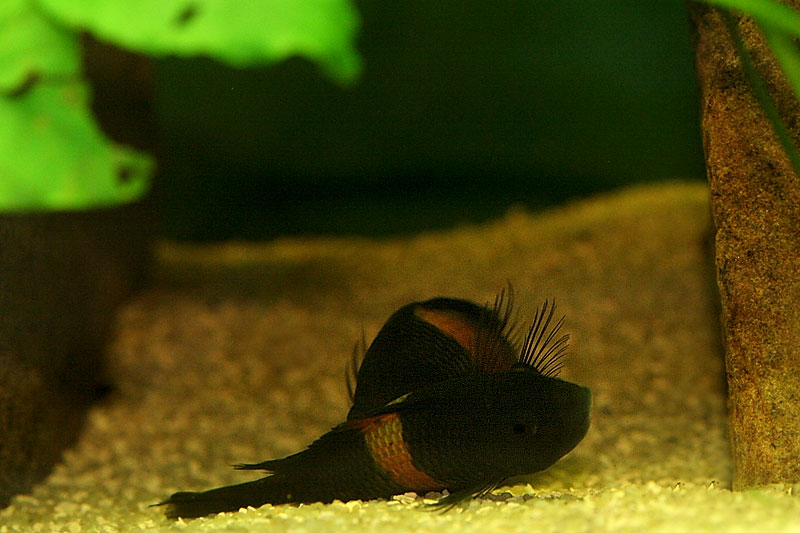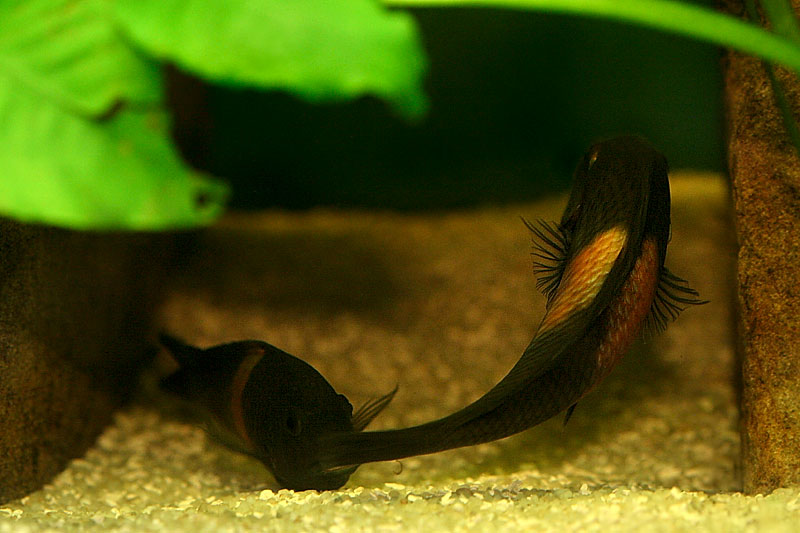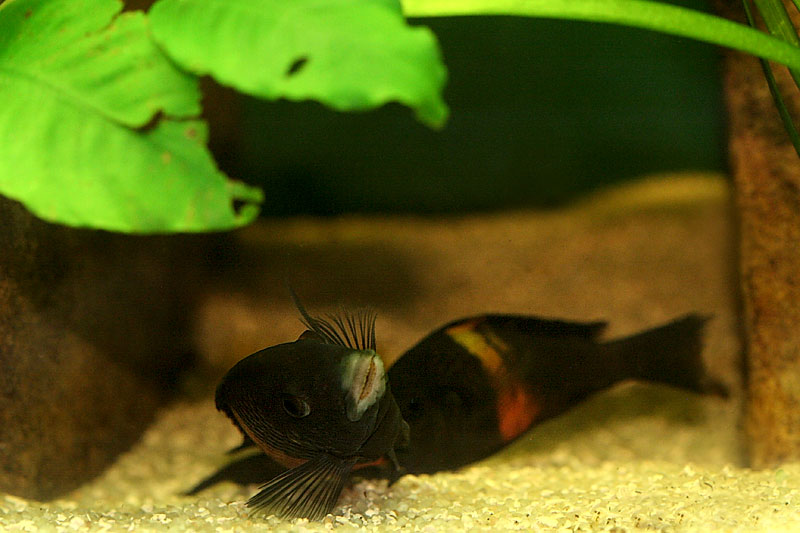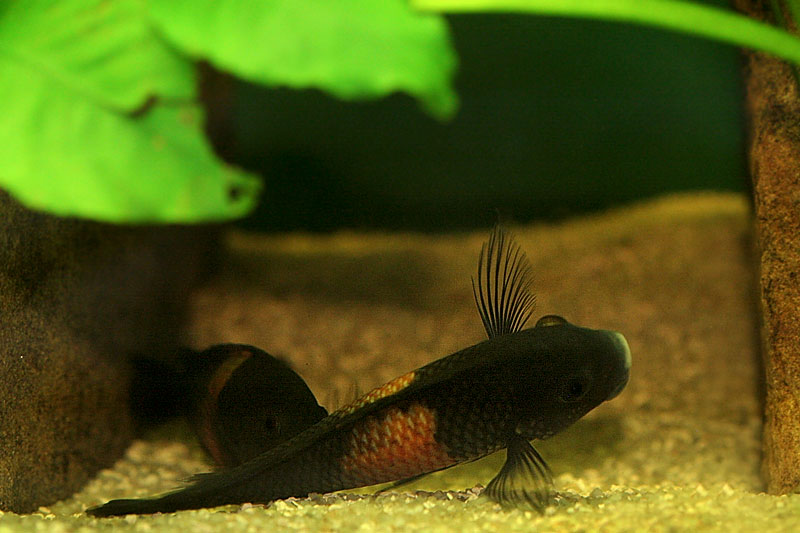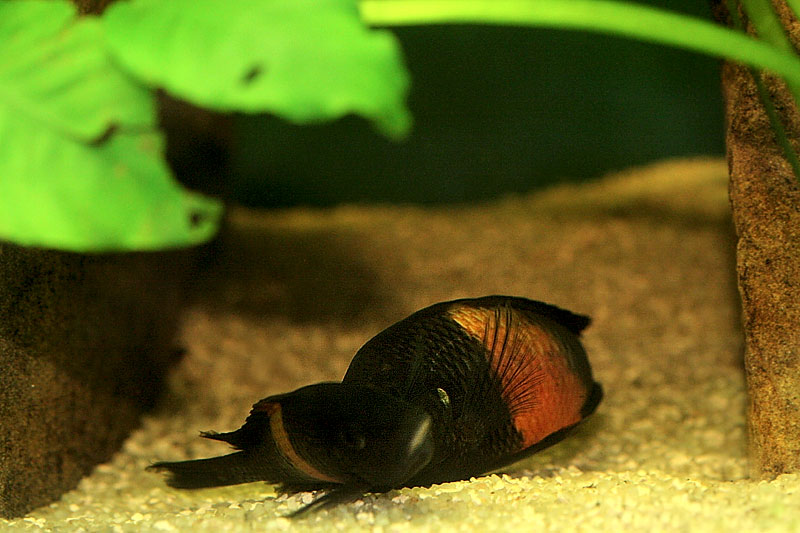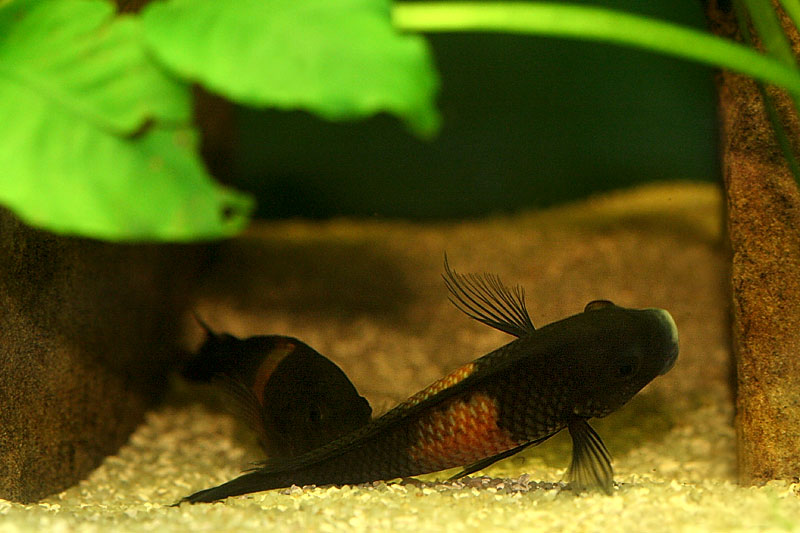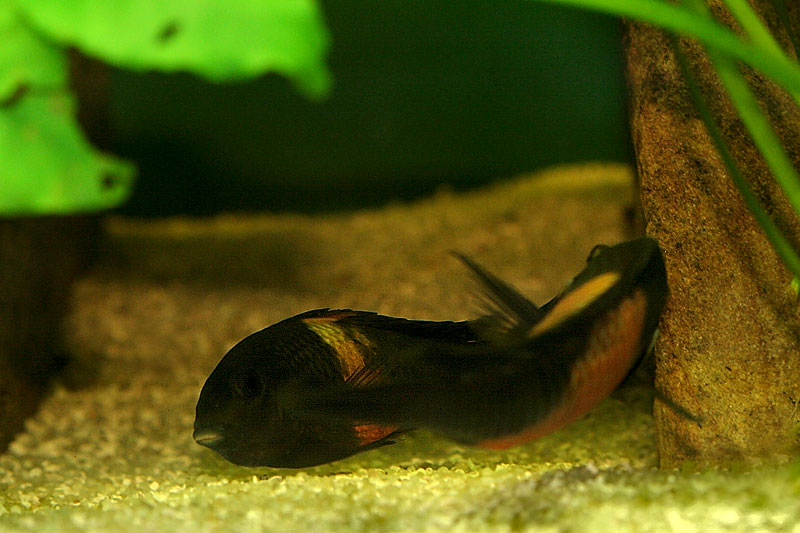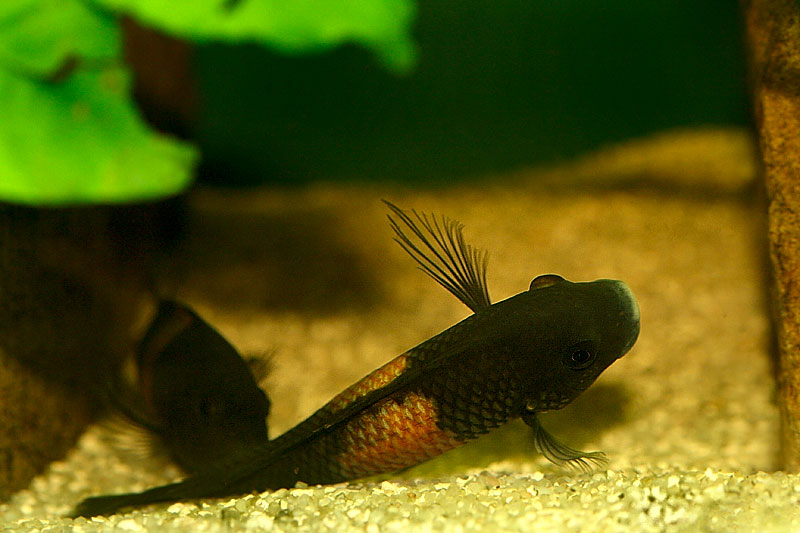Tropheus [Tropheus sp. ‘Black’ (Pemba Orange Flame)]
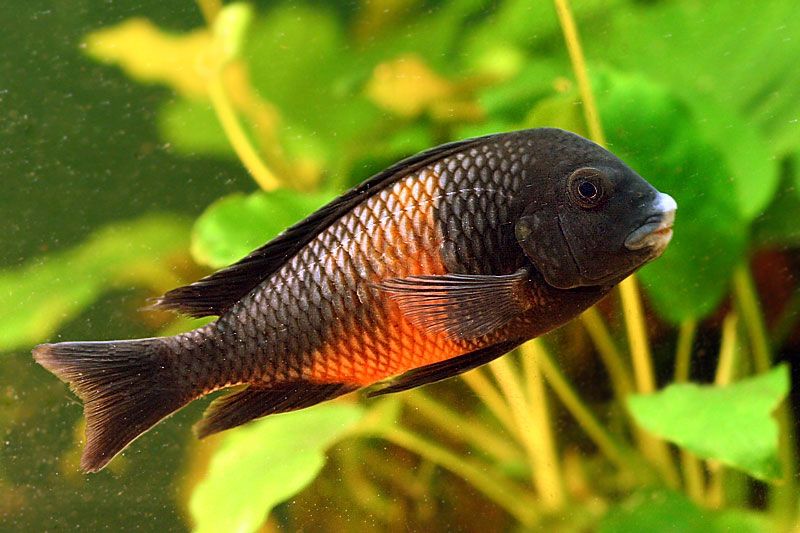 Dominant male, February 2009.
The main fish in this tank are a colony of Tropheus sp. ‘Black’ (Pemba Orange Flame). My original stock was sold as colony of 25, but there were 27 in the bag. Unfortunately I lost two during the first couple of days when they were getting used to my water, so I was back to 25. Over a year later, I have not lost any more of the original 25, and they have been breeding for a few months, which means there are fry of various sizes coming out of the woodwork all over the tank!
The fish came from fellow aquarist Brian Shrimpton, who donated them to be auctioned off for the benefit of the OCA Jim Smith Fund at the 2007 OCA X-mas Party. I got them for $150 including 5 pounds of Xtreme cichlid crumble (worth about $50). I consider that to be a steal, even without the included food. However, the food was an extra bonus since tropheus have a reputation about being touchy regarding what kind of food they eat, and I was grateful for not having to change their diet - which I haven't to this day, and probably never will! Brian also included a few photos of the parents of my fish, which you can see here:
Until I had the 125G tank ready to house the tropheus, they had to make do with a 10G tank in my basement. At the time, they all comfortably fit in there!
Eventually the 125G tank was ready to accommodate them. A strong filter (Eheim 2260 with Eheim Diffusor), created a wicket current in the right most part of the tank. The little guys were struggling to get over there, but hey always seemed to enjoy the challenge. Also, I do think a strong current can help with aggression control.
Dominant male, February 2009.
The main fish in this tank are a colony of Tropheus sp. ‘Black’ (Pemba Orange Flame). My original stock was sold as colony of 25, but there were 27 in the bag. Unfortunately I lost two during the first couple of days when they were getting used to my water, so I was back to 25. Over a year later, I have not lost any more of the original 25, and they have been breeding for a few months, which means there are fry of various sizes coming out of the woodwork all over the tank!
The fish came from fellow aquarist Brian Shrimpton, who donated them to be auctioned off for the benefit of the OCA Jim Smith Fund at the 2007 OCA X-mas Party. I got them for $150 including 5 pounds of Xtreme cichlid crumble (worth about $50). I consider that to be a steal, even without the included food. However, the food was an extra bonus since tropheus have a reputation about being touchy regarding what kind of food they eat, and I was grateful for not having to change their diet - which I haven't to this day, and probably never will! Brian also included a few photos of the parents of my fish, which you can see here:
Until I had the 125G tank ready to house the tropheus, they had to make do with a 10G tank in my basement. At the time, they all comfortably fit in there!
Eventually the 125G tank was ready to accommodate them. A strong filter (Eheim 2260 with Eheim Diffusor), created a wicket current in the right most part of the tank. The little guys were struggling to get over there, but hey always seemed to enjoy the challenge. Also, I do think a strong current can help with aggression control.
 Full tank shot shortly after adding fish. In addition to the tropheus, I had an adult pair of multies in the tank at the time.
By September 2008 the valisneria had taken over half of the tank giving it an overgrown and somewhat unkempt look. However, the tropheus had also begun to breed and the abundant plant growth had provided ample cover for fry.
Full tank shot shortly after adding fish. In addition to the tropheus, I had an adult pair of multies in the tank at the time.
By September 2008 the valisneria had taken over half of the tank giving it an overgrown and somewhat unkempt look. However, the tropheus had also begun to breed and the abundant plant growth had provided ample cover for fry.
 A somewhat unkempt look in September 2008 with Valisneria sp having taken over large parts of the tank.
By October 2008 I had put the valisneria back in their place, but I had neither trimmed them nor thinned out the thicket, waiting for the OCA Winter Auction in February to sell some of the plants.
A somewhat unkempt look in September 2008 with Valisneria sp having taken over large parts of the tank.
By October 2008 I had put the valisneria back in their place, but I had neither trimmed them nor thinned out the thicket, waiting for the OCA Winter Auction in February to sell some of the plants.
 October 2008, valisneria confined to their space, but not yet trimmed or thinned out.
In February 2009 I took a good deal of the valisneria out, and sold those plants at the OCA Winter Auction. I also got rid on the stem plant on the very left (Hydrocotyle leucocephala), because I was tired of having to replant it after the tropheus kept pulling it out. Finally, I brought the red leafed Amazon Sword Plant on the left forward into the space where the stem plant had been. I also dyed the white PVC used for the overflow for the CAWC system black, to make it a bit less obtrusive. Last but not least, I installed a trim piece over the fake oak colored bottom of the tank to make it blend better with the cabinet. With these changes made, the tank finally looks like I envisaged it from the outset!
October 2008, valisneria confined to their space, but not yet trimmed or thinned out.
In February 2009 I took a good deal of the valisneria out, and sold those plants at the OCA Winter Auction. I also got rid on the stem plant on the very left (Hydrocotyle leucocephala), because I was tired of having to replant it after the tropheus kept pulling it out. Finally, I brought the red leafed Amazon Sword Plant on the left forward into the space where the stem plant had been. I also dyed the white PVC used for the overflow for the CAWC system black, to make it a bit less obtrusive. Last but not least, I installed a trim piece over the fake oak colored bottom of the tank to make it blend better with the cabinet. With these changes made, the tank finally looks like I envisaged it from the outset!
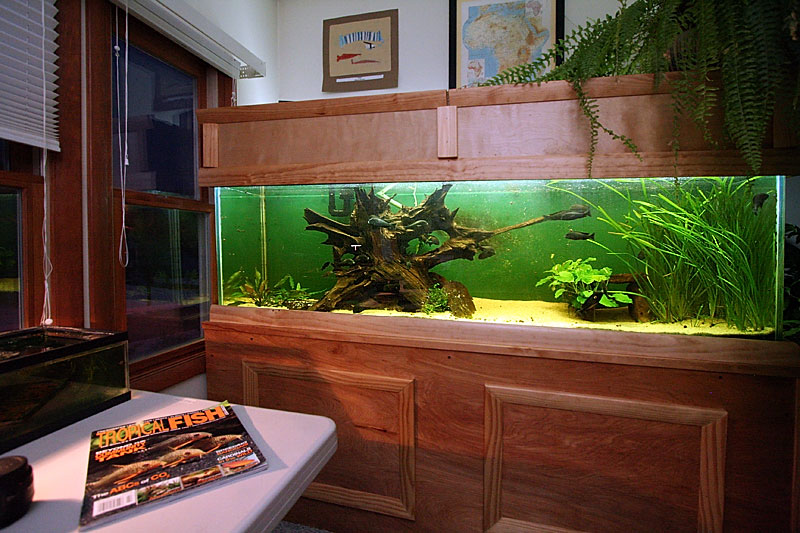 This is how I see the tank from the chair in front of my desk.
I think the tropheus wanted to reward me by putting on a huge spawning performance for me a few days after I finished! That day I happened to sit next to the tank, when I saw the dominant male and one of the females in the typical T-position. I only knew what it was from other people's photos, never before having had a chance to observe them spawning myself. I goes without saying that I was extremely excited. I needn't have rushed with the camera though, because they were busy for hours. The spawning site was the male's favorite cave, and he kept on coming out showing off for the females and enticing one after the other into the cave to do their thing. It was probably the most amazing spectacle I have observed in over 30 years of fish keeping! Being able to see the fascinating natural behavior of these wild African animals right there from the comfort of your arm chair is what this hobby is all about for me! It is moments like these that make up for years of hard work doing tank maintenance!
I am pretty sure all, or nearly all of my females must have spawned. Interestingly, they still seem to ingest some food despite the fact that they are now holding eggs. I never changed from the diet of Xtreme cichlid crumble, which I bought with my tropheus colony. Unlike pellets, the crumble has some smaller parts in there, and that might actually help holding females in taking up some food. I also saw another male being busy chasing around, and I wondered if he managed to fertilize some eggs. After some comments I got on Cichlid-forum, I am pretty sure he did, but his favorite cave is invisible behind the large piece of driftwood. I am lucky in that one male chose a reasonably photogenic spot!
Obviously spawning behavior will put extra stress on the colony, but I haven't seen any sub-dominant individuals looking unduly harassed. However, I did notice on the day after the big spawning frenzy that one of the sub-dominant males made a serious grab for leadership. The rebel lip locked with the dominant male for several minutes and they went round and round in circles. I had never seen a fight of anywhere near that severity in the tank. Usually there is just a constant chasing and nudging going on, but nothing particularly serious. I am assuming that the dominant male was a little exhausted and less watchful than usual after all the spawning activity, and the rebel saw a chance for a coup d’état! The dominant male seemed to be getting the situation under control, however, since he is still patrolling the tank as usual and wearing his bright orange band. I found it interesting to observe that even in the midst of the fight, the challenger remained black with virtually no orange, although especially the females on the colony can change color in an instant depending on their mood.
Initially I assumed after the big frenzy I would not see any spawning activity for a while, and I observed none on the day after. One day later, however, I saw the male a few times with a female in T-position in the cave, and I continued to observe this for several days afterwards.
This is how I see the tank from the chair in front of my desk.
I think the tropheus wanted to reward me by putting on a huge spawning performance for me a few days after I finished! That day I happened to sit next to the tank, when I saw the dominant male and one of the females in the typical T-position. I only knew what it was from other people's photos, never before having had a chance to observe them spawning myself. I goes without saying that I was extremely excited. I needn't have rushed with the camera though, because they were busy for hours. The spawning site was the male's favorite cave, and he kept on coming out showing off for the females and enticing one after the other into the cave to do their thing. It was probably the most amazing spectacle I have observed in over 30 years of fish keeping! Being able to see the fascinating natural behavior of these wild African animals right there from the comfort of your arm chair is what this hobby is all about for me! It is moments like these that make up for years of hard work doing tank maintenance!
I am pretty sure all, or nearly all of my females must have spawned. Interestingly, they still seem to ingest some food despite the fact that they are now holding eggs. I never changed from the diet of Xtreme cichlid crumble, which I bought with my tropheus colony. Unlike pellets, the crumble has some smaller parts in there, and that might actually help holding females in taking up some food. I also saw another male being busy chasing around, and I wondered if he managed to fertilize some eggs. After some comments I got on Cichlid-forum, I am pretty sure he did, but his favorite cave is invisible behind the large piece of driftwood. I am lucky in that one male chose a reasonably photogenic spot!
Obviously spawning behavior will put extra stress on the colony, but I haven't seen any sub-dominant individuals looking unduly harassed. However, I did notice on the day after the big spawning frenzy that one of the sub-dominant males made a serious grab for leadership. The rebel lip locked with the dominant male for several minutes and they went round and round in circles. I had never seen a fight of anywhere near that severity in the tank. Usually there is just a constant chasing and nudging going on, but nothing particularly serious. I am assuming that the dominant male was a little exhausted and less watchful than usual after all the spawning activity, and the rebel saw a chance for a coup d’état! The dominant male seemed to be getting the situation under control, however, since he is still patrolling the tank as usual and wearing his bright orange band. I found it interesting to observe that even in the midst of the fight, the challenger remained black with virtually no orange, although especially the females on the colony can change color in an instant depending on their mood.
Initially I assumed after the big frenzy I would not see any spawning activity for a while, and I observed none on the day after. One day later, however, I saw the male a few times with a female in T-position in the cave, and I continued to observe this for several days afterwards.
Leave a Reply
You must be logged in to post a comment.
